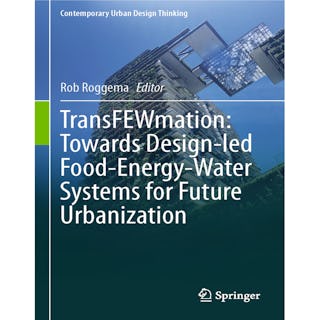TransFEWmation: Towards Design-Led Food-Energy-Water Systems for Future Urbanization
contemporary urban design thinking: rob roggema, editor

This book discusses a spectrum of approaches to designing the food-energy-water nexus at different spatial-urban scales. The book offers a framework for working on the FEW-nexus in a design-led contexts and integrates the design of urban neighborhoods and regions with methodologies that simultaneously engage residents and stakeholders and evaluating the propositions in a FEW-print, measuring the environmental impact of the different designs. The examples are derived from on the ground practices in Sydney, Tokyo, Detroit, Amsterdam and Belfast.
RVTR’s contribution (by Thün, Sanyal and Velikov) implicates intersecting human and biological systems, flows, and exchanges that operate at multiple and often nested scales. For designers working on transforming FEW-systems it is therefore important to think across these scales and their interrelationships. Multiscalar consideration enables insight on effectiveness and impact of strategies and also provides the ability to recognize synergistic opportunities, barriers to be overcome, and externalities necessary to be considered. Additionally, in a multilevel governance context of the United States, many policies that impact food, energy, and water are defined and administered at the sub-federal state level, creating a heterogeneous terrain of approaches, applications, and opportunities, depending on locale. This study aims to describe a model for thinking and apprehending FEW-systems across nested and cascading scales. Across scales from Ecological: Great Lakes Megaregion, the Jurisdictional: State of Michigan, and the Urban: City of Detroit, divergent opportunities and constraints are articulated for developing FEW-nexus based urban design and policy-based interventions that across scale of consideration, identify multiple and differentiated points of leverage within the system.
The ecosystem scale avails views to alternate energy futures and water policy beyond those defined by the state. The jurisdictional state-scale reveals the impacts of policies and the constraints produced through their intended and unintended consequences. It points to excesses that might be leveraged to produce new economies and ecologies. At the scale of the city, the unique opportunities and challenges can now be rethought in light of broader contexts. In some instances, alignment between local interventions and region-wide imperatives might help to reinforce the primacy of a given strategy. In others, the local context might argue for special exceptions to jurisdictional frameworks whose underlying principles are without traction. The work aims to outline an approach that is portable and may be translated to other urban contexts.
Order a Copy of TransFEWmation